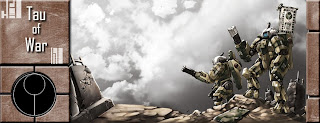by Matt-Shadowlord

Fortifications are suddenly a hot-topic again. We’re about to get an injection of new Fortifications into the game, as several Apocalypse releases will also have 40K profiles and points-costs. Even the usually rational AbusePuppy is working on building his own extravagant fortress.
The first thing a Tournament player needs to know about the Fortification Rules is that nobody plays by the Fortification Rules.
This article has two goals. The first is to make players aware of what Tournament Organiser (TO) rulings they may have to deal with if they decide to take a fortification to a tournament. When we're talking about spending up to 290 pts on non-scoring, non-contesting, immobile terrain pieces that don't even count as part of your army it's extremely important to know what use you're actually going to be able to make of them.
The second is to take a look at rulings made at various events to hopefully filter some ideas through to TOs who are trying to decide how to handle these structures at their own future events.
A Tale of Five Fortifications
1) Fortifications that don’t fit will be destroyed.
Reported by Clever Handle:“In my area you get these rules:
Terrain is adjusted by the TO's immediately prior to calling round pairings. Fortifications must be placed a minimum of 3″ away from any pre-positioned terrain piece. If your fortification can't be deployed because of the previous rule it counts as destroyed.”
2) No Fortifications are allowed
When the 6th edition rule book came out, this was expected to be the common response, and 40K sites with articles from that period are still littered with comments to that effect. The truth is that a ban on fortifications does happen, but is very rare.3) Fortifications remove existing terrain
Reported by AbusePuppy:“TSHFT uses a rule that ‘you have to pull one piece of terrain from your half when deploying a fortification'. Different terrain pieces are given different “values” that are supposed to roughly correspond to the terrain densities from the BRB rules, but not all of them are marked and you have to remove at pieces worth at least as much as the one you're putting on.”
4) No Fortification shall be placed within 3″ of another piece of terrain or fortification, other than an aegis defence line which can be placed in and around terrain.
This is a common ruling locally, so to show one of the most prominent (and influential) versions I have copied the following in full from the Australian Team Championship (ATC) rules pack“1. No Fortification shall be placed within 3″ of another piece of terrain or fortification, with the exclusion of an aegis defence line which can be placed in and around terrain.
2. If the player can find no location to place the fortification that they desire they may remove 1 piece of terrain that is situated entirely in their table half, and then place the fortification approximately in that location.
3. In the case of a Fortress of Redemption a player can remove up to 2 pieces of neighbouring terrain pieces and place the Fortress of Redemption approximately in that location.”
5) No Fortification shall be placed within 3″ of another piece of terrain or fortification, including the Aegis Defence Line.
Reported by Difsta:“Most tournaments I have seen have the terrain pre placed by the TO, so the rule is you cannot place a forification within 3″ of a piece of terrain. I know a range of tournaments with different TOs that rule that your placement of the aegis line is not legal. Not because it is in an E shape or any other shape, because you have it going through a piece of terrain.”
This was posted as a comment in response to a battle report here on 3plusplus, so it’s easy to demonstrate. Difsta’s comment was that some Tournament Organisers would rule against placement like Aegis in the bottom centre where it overlaps some trees and is near a central piece of terrain.

That's a list of five quite different ways to handle fortifications, but the eagle-eyed reader will have noticed the one thing they have in common:
None of them are according to the rule book.
The rule book’s method of placing terrain and fortifications is very impractical for Tournaments –it’s rarely even used verbatim for friendly games, since few people actually see much point to rolling off for side of the table while the table has no terrain on it.
That ends the fact-based part of this article, and I'd now like to offer an opinion which is essentially that if every method used for placing fortifications at a tournament is essentially a house-rule, we should attempt to be gentlemen about those rules.
1) Fortifications that don’t fit will be destroyed.
This rule is by far the worse of the lot. It goes a long way to betraying a TO’s personal views on fortifications existing in the rules. We don’t all have to like them, but the chance a player might start with a deficit of 75, 220 or even 290 pts destroys the level playing field required for a competitive event.2) No Fortifications are allowed
As mentioned above, this is rare. I am against this because some armies rely on fortifications for their sole meagre chance at skyfire, and banning them improves flyer-based armies at their expense.In my opinion it’s still better than Rule 1 though, since not having a fortification is a lesser evil than to thinking you have one and losing it before the game!
3) Fortifications remove existing terrain
This is a common and (in my opinion) sensible rule, except when it includes the Aegis wall. Removing a hill to place a bastion out of necessity is one thing, but allowing players to remove large amount of terrain to place a 28” long wall is very different and completely open to gaming.You can see the effect of this in AbusePuppy's report from TSHFT where he and other players used Aegis walls to remove line-of-sight blockers and difficult terrain from the centre of the board.

If the TO gives players such power you can hardly blame them for using it, but it’s still desperately gamey and changes the balance of the game.

To give another example, in the battle report mentioned above the impassable terrain in the centre meant splitting my army in two to get the Deamons to the Tau. I’d have sacrificed a thousand Ethereals on the altar of Khorne to have a chance to remove it – and if a TO ruled I could remove it just by placing an Aegis in its location I’d be foolish not to take advantage of it. I would be taking advantage though.
4) No Fortification shall be placed within 3″ of another piece of terrain or fortification other than an aegis defence line which can be placed in and around terrain.
Most implementations of this rule do require/allow a piece of terrain to be removed with TO approval when placing a large fortification, but they essentially ignore the Aegis wall.The Aegis is by far the most common fortification people take for good reason – it’s cheap, effective and it can fit virtually anywhere. If people put it in terrain or run it through a forest or ruin they are usually doubling-up on a cover save the wall already gave them, so opponents have little reason to complain.
Letting players just get on with it and place their walls anywhere in their table half reduces overhead for the TOs, who should then find it more easy to deal with the 1 in 10 who bring something more chunky that actually requires attention.
This is my favourite solution of the lot, and probably the one used most often.
5) No Fortification shall be placed within 3″ of another piece of terrain or fortification including the Aegis Defence Line.
This is very similar to the rule above, and at first sounds like it’s closer to the rule book, which doesn’t distinguish between the Aegis and any other fortification. However in reality by the letter of the law it is impossible for an Aegis in your own half of the table to be placed in an illegal position – it’s always the terrain that should be 3” from it rather than vice-versa.
Since that means this is just another house rule, there is very little to be gained by trying to attempt it and it is a lot less practical than just placing the Aegis. It would require terrain to be just over 6” apart, and the existing terrain would dictate the exact path the wall follows. We’re talking about a lot of hassle and weird placement for not much gain.
In conclusion:
I’ve described five different ways Fortifications are treated at tournaments, and none of them are RAW. If you take a step back from how rigid most 40K players are about the rules, the great surprise is that everyone seems to be fine with this. And so they should be -in many ways, 40K is like a game.To Tournament Organisers I recommend using a version of “4) No Fortification shall be placed within 3″ of another piece of terrain or fortification other than an aegis defence line which can be placed in and around terrain.” It’s fairly simple, low maintenance, and a lot less vulnerable to people ‘gaming’ the system.
I can’t recommend against the rule ‘Fortifications that don't fit will be destroyed’ enough – better to ban them entirely than to gouge out a piece of someone’s army based on the random chance of which table they are assigned to and how densely populated with terrain it is.
To Players, if you plan to use anything more ambitious than the Aegis wall, I recommend checking what rules the event will be using before sending in an army list. Losing a sky shield to TO rules would be a tragedy, but losing a bastion with a quadgun or a Fortress of Redemption would be a disaster.
-Matt
PS – I listed the five I am aware of, but if anyone knows of other rules used for Fortifications at tournaments post below and I will add it to the post-script.








